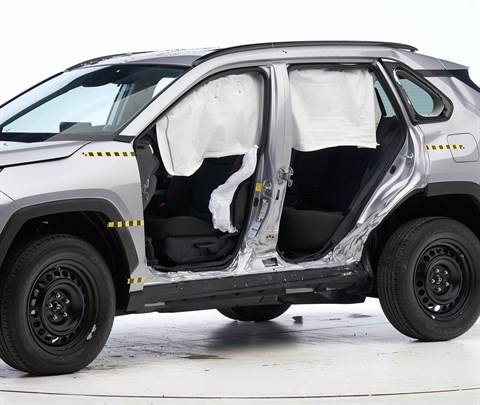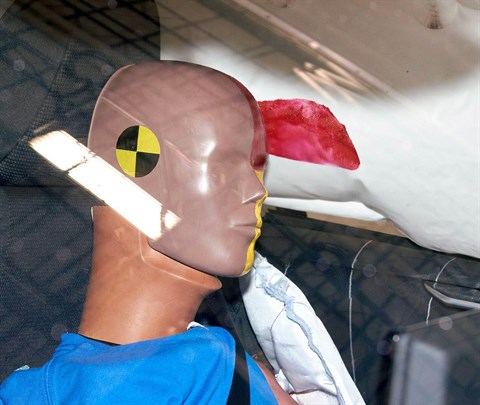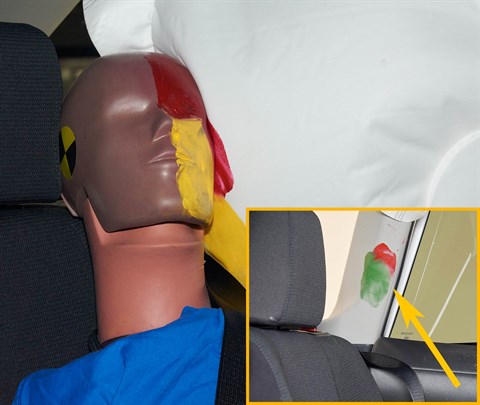Small overlap front
The small overlap front evaluation consists of a driver-side and a passenger-side component. If the results of the two evaluations differ, then the combined small overlap rating is equal to the lower rating.
Driver-side
- Rating applies to 2021-24 models
Tested vehicle: 2021 Toyota RAV4 Prime SE 4-door 4wd
The Toyota RAV4 Prime, a plug-in hybrid variant of the Toyota RAV4, was introduced in the 2021 model year. Beginning with 2025 models, the RAV4 Prime became known as the RAV4 Plug-in Hybrid. Driver-side small overlap frontal ratings are assigned by the Institute based on a test of a 2021 RAV4 Prime conducted by Toyota.
| Evaluation criteria | Rating |
|---|---|
| Overall driver-side evaluation | |
| Structure and safety cage | |
| Driver injury measures | |
| Head/neck | |
| Chest | |
| Hip/thigh | |
| Lower leg/foot | |
| Driver restraints and dummy kinematics | |
Passenger-side
- Rating applies to 2021-24 models
Tested vehicle: 2021 Toyota Rav4 Prime SE 4-door 4wd
The Toyota RAV4 Prime, a plug-in hybrid variant of the Toyota RAV4, was introduced in the 2021 model year. Beginning with 2025 models, the RAV4 Prime became known as the RAV4 Plug-in Hybrid. Passenger-side small overlap frontal ratings are assigned by the Institute based on a test of a 2021 RAV4 Prime conducted by Toyota.
| Evaluation criteria | Rating |
|---|---|
| Overall passenger-side evaluation | |
| Structure and safety cage | |
| Passenger injury measures | |
| Head/neck | |
| Chest | |
| Hip/thigh | |
| Lower leg/foot | |
|
Passenger restraints and dummy kinematics
The dummy’s head contacted the right side of the frontal airbag but began to slide into the gap between the frontal and side curtain airbags, contacting the dislodged A-pillar trim. The inflated side curtain airbag has sufficient forward coverage to protect the head from contact with side structure and outside objects. | |
| Driver injury measures | |
| Head/neck | |
| Chest | |
| Hip/thigh | |
| Lower leg/foot | |
| Driver restraints and dummy kinematics | |
Moderate overlap front: original test
Rating applies to 2021-24 models
Tested vehicle: 2021 Toyota RAV4 Prime SE 4-door 4wd
The Toyota RAV4 Prime, a plug-in hybrid variant of the Toyota RAV4, was introduced in the 2021 model year. Beginning with 2025 models, the RAV4 Prime became known as the RAV4 Plug-in Hybrid. Moderate overlap frontal ratings are assigned by the Institute based on a test of a 2021 RAV4 Prime conducted by Toyota.
| Evaluation criteria | Rating |
|---|---|
| Overall evaluation | |
| Structure and safety cage | |
| Driver injury measures | |
| Head/neck | |
| Chest | |
| Leg/foot, left | |
| Leg/foot, right | |
| Driver restraints and dummy kinematics | |
Side: original test
Rating applies to 2021-24 models
Tested vehicle: 2021 Toyota RAV4 Prime SE 4-door 4wd
The Toyota RAV4 Prime, a plug-in hybrid variant of the Toyota RAV4, was introduced in the 2021 model year. Beginning with 2025 models, the RAV4 Prime became known as the RAV4 Plug-in Hybrid. Side ratings are assigned by the Institute based on a test of a 2021 RAV4 Prime conducted by Toyota.
| Evaluation criteria | Rating |
|---|---|
| Overall evaluation | |
| Structure and safety cage | |
| Driver injury measures | |
| Head/neck | |
| Torso | |
| Pelvis/leg | |
| Driver head protection | |
| Rear passenger injury measures | |
| Head/neck | |
| Torso | |
| Pelvis/leg | |
| Rear passenger head protection | |
Side: updated test
Rating applies to 2023-24 models
Tested vehicle: 2021 Toyota RAV4 LE 4-door 4wd
The Toyota RAV4 was redesigned for the 2019 model year. The Toyota Venza was re-introduced to the market as a small SUV in the 2021 model year and shares the same platform as the RAV4. These ratings also apply to the Toyota RAV4 Prime, now known as the RAV4 Plug-in Hybrid beginning with 2025 models.
| Evaluation criteria | Rating |
|---|---|
| Overall evaluation | |
| Structure and safety cage | |
| Driver injury measures | |
| Head/neck | |
| Torso | |
| Pelvis | |
| Driver head protection | |
| Rear passenger injury measures | |
| Head/neck | |
| Torso | |
| Pelvis | |
|
Rear passenger head protection
Part of the dummy's head moved beyond the rear portion of the side curtain airbag and contacted the C-pillar hard. The head protection is inadequate. | |

View of the vehicle just after the crash test.

View of the vehicle after the crash with doors removed, showing the side airbags and damage to the occupant compartment.

Smeared greasepaint shows where the driver dummy's head was protected from being hit by hard structures by the side airbags.

Smeared greasepaint shows where the rear passenger dummy's head struck the C-pillar (inset) despite the deployment of the side curtain airbag.
Headlights
Trim level(s)
- All trims
| Evaluation criteria | Rating |
|---|---|
| Low-beam headlight type | LED projector |
| High-beam headlight type | LED projector |
| Curve-adaptive? | No |
| High-beam assist? | Yes |
|
Overall rating | |
| Distance at which headlights provide at least 5 lux illumination: | |
Low beams
On the straightaway, visibility was good on both sides of the road. On curves, visibility was good on both right curves, fair on the sharp left curve and inadequate on the gradual left curve.
The low beams never exceeded glare limits.
High beams
On the straightaway, visibility was good on the right side of the road and fair on the left side. On curves, visibility was fair on the gradual right and gradual left curves and inadequate on the sharp right and sharp left curves.
High-beam assist compensates for some limitations of this vehicle's low beams on the straightaway and on both left curves.
Front crash prevention: vehicle-to-vehicle 2.0
Front crash prevention: pedestrian
Child seat anchors
Rating applies to 2021-24 models
| Evaluation criteria | Rating |
|---|---|
| Overall evaluation | + extra LATCH positions |
| Vehicle trim | LE |
| Seat type | cloth |
This vehicle has 2 rear seating positions with complete child seat attachment (LATCH) hardware.
It has 1 additional seating position with a tether anchor and the ability to borrow lower anchors from the other seating positions.
Note: When anchors are borrowed, they aren't available to use in their designated positions.
| Evaluation criteria | Rating |
|---|---|
| Overall evaluation | + extra LATCH positions |
| Vehicle trim | LE |
| Seat type | cloth |
| Rating icon | Rating |
|---|---|
| G | Good |
| A | Acceptable |
| M | Marginal |
| P | Poor |
| Seating positions that rely on borrowed lower anchors or have only a tether anchor available are not rated. | |
thether anchor symbol | Tether anchor |
lower anchor symbol | Lower anchors |
| Lower anchor(s) can be borrowed from adjacent positions(s) | |
| No hardware available |
Details by seating position
| Position | Rating |
|---|---|
| 1 | |
| Tether anchor | |
| easy-to-find location | |
| no other hardware could be confused for anchor | |
| Lower anchors | |
| not too deep in seat | |
| not too much force needed to attach | |
| easy to maneuver around anchors | |
| 2 | |
| Tether anchor | |
| easy-to-find location | |
| no other hardware could be confused for anchor | |
| Lower anchors | |
| Can be borrowed from 1 and 3 | |
| 3 | |
| Tether anchor | |
| easy-to-find location | |
| no other hardware could be confused for anchor | |
| Lower anchors | |
| not too deep in seat | |
| not too much force needed to attach | |
| easy to maneuver around anchors |
